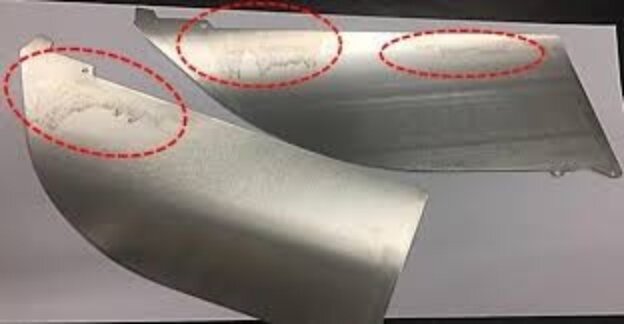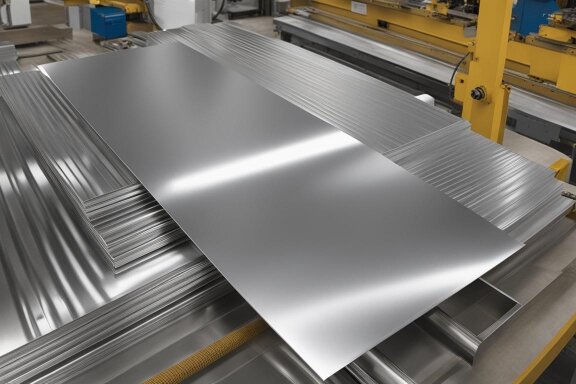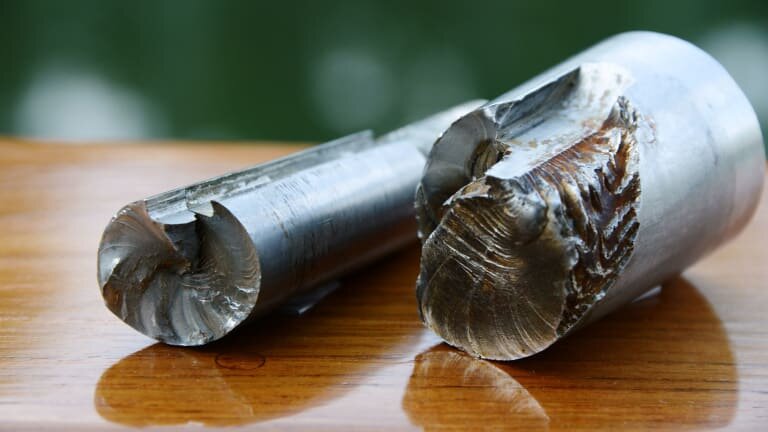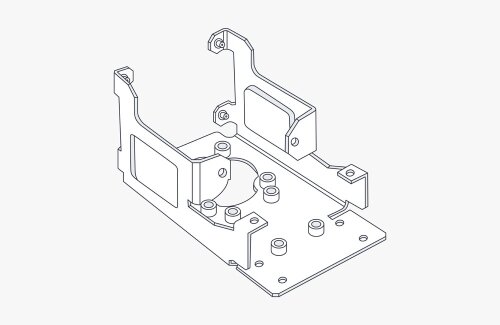يمكن أن يكون تصنيع المعادن معقداً. يعاني العديد من المهندسين والمصممين في اختيار التقنية المناسبة لمشاريعهم. وغالباً ما يؤدي ذلك إلى تأخيرات وزيادة التكاليف ونتائج دون المستوى. ولكن مع المعرفة الصحيحة، يمكنك اتخاذ قرارات مستنيرة وتحقيق أفضل النتائج.
الثقب واللكم والقص هي ثلاث تقنيات أساسية لتصنيع المعادن. كل طريقة لها خصائص وتطبيقات فريدة. الثقب يخلق ثقوبًا دون إزالة المواد. اللكم يقطع أشكالًا من الصفائح المعدنية. القص ينتج قطعًا منفصلة من صفائح أكبر.
دعنا نستكشف كل تقنية بالتفصيل. سنغطي عملياتها ومزاياها وحالات الاستخدام المثالية. ستساعدك هذه المعلومات على اتخاذ قرارات أفضل في مشاريع تصنيع المعادن الخاصة بك.
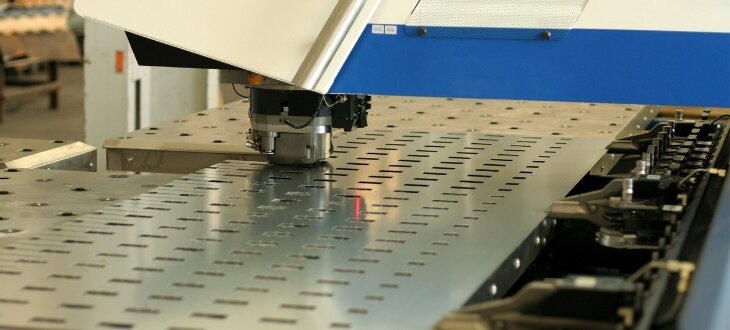
أساسيات عمليات قطع المعادن
ما هو الثقب؟
الثقب هو تقنية تصنيع المعادن تُحدث ثقوبًا في الصفائح المعدنية. تستخدم المثقاب لاختراق المادة وتشكيل فتحة دون إزالة أي معدن. تعمل هذه العملية على إزاحة المادة، وغالباً ما تُحدِث انتفاخاً طفيفاً حول حافة الثقب.
يعمل الثقب بشكل جيد لإنتاج ثقوب صغيرة ودقيقة في الصفائح الرقيقة. ويُستخدم عادةً في صناعات مثل السيارات والإلكترونيات.
ما هو اللكم؟
اللكم تتضمن قطع أشكال محددة من الصفائح المعدنية. حيث تقوم مكابس التثقيب بدفع أداة من خلال المادة، مما يخلق شكلاً محددًا مسبقًا. وعادةً ما يتم التخلص من القطعة المقطوعة، التي تسمى سبيكة، كخردة.
تتفوق هذه التقنية في صنع أشكال قابلة للتكرار بسرعة. وهي مثالية لإنتاج القِطع بكميات كبيرة بميزات متناسقة.
ما هو الطمس؟
تقطيع هي عملية تقطع الشكل المطلوب من صفيحة معدنية أكبر حجماً. وعلى عكس التثقيب، فإن القطعة المقطوعة في عملية التثقيب هي المنتج النهائي وليس الخردة. وتصبح الصفيحة المتبقية هي النفايات.
تنتج هذه الطريقة أجزاء مسطحة وموحدة بحواف نظيفة. وهي فعالة للغاية في صنع كميات كبيرة من القطع المتماثلة.
كيفية عمل الثقب واللكم والطمس
آلية الثقب في تصنيع المعادن
يُعد الثقب عملية دقيقة. وإليك طريقة عملها:
- أداة حادة تُسمى المثقاب تحاذي الصفيحة المعدنية.
- تتحرك اللكمة إلى الأسفل بقوة.
- يخترق المعدن، محدثًا ثقبًا صغيرًا.
- ويسقط المعدن الزائد، أو السبيكة، من خلال قالب أسفلها.
العملية سريعة وقابلة للتكرار. وهي مثالية لإنشاء عدة ثقوب صغيرة في عملية واحدة.
ميكانيكية التثقيب في تصنيع المعادن
يتبع اللكم مبدأً مشابهاً لمبدأ الثقب ولكن على نطاق أوسع:
- مثقاب وقوالب مثقوبة في مكبس.
- توضع الصفيحة المعدنية بينهما.
- تندفع اللكمة لأسفل بقوة كبيرة.
- يدفع من خلال المعدن، مما يخلق فتحة.
- يتراجع المثقاب، تاركاً الثقب المطلوب.
يمكن أن يخلق التثقيب أشكالاً مختلفة. يحدد المثقاب والقالب الشكل النهائي.
آلية التقطيع في تصنيع المعادن
يقطع الطمس أشكالاً كاملة من الصفائح المعدنية:
- قالب مصمم خصيصاً على مكبس.
- يتم تغذية الصفيحة المعدنية في المكبس.
- ينزل النرد بقوة.
- يقطع المعدن، ويفصل الشكل المطلوب.
- تصبح القطعة المقطوعة هي المنتج النهائي.
ينتج عن الطمس حواف نظيفة على القطعة المقطوعة. تصبح الصفيحة المعدنية المتبقية خردة.
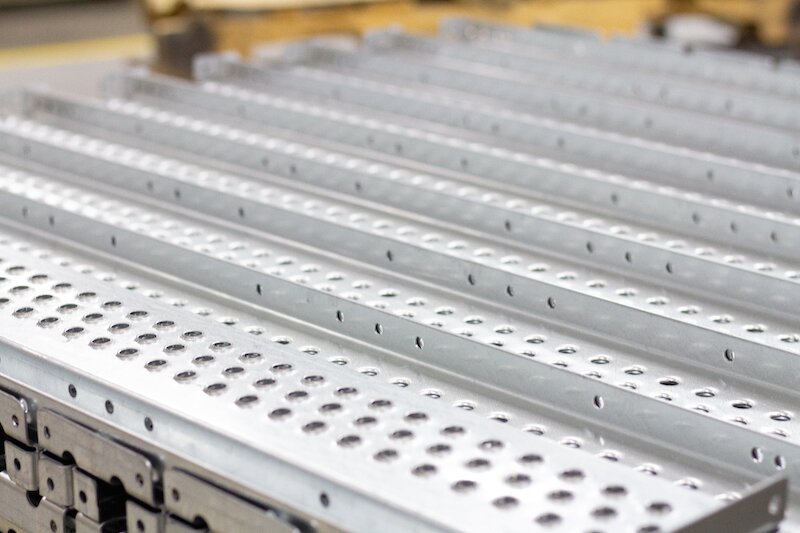
مقارنة الاختلافات الرئيسية
إزالة المواد: الثقب مقابل التثقيب مقابل التثقيب مقابل الطمس
يبرز الثقب في هذه المقارنة. فهو لا يزيل المواد من الصفيحة. وبدلاً من ذلك، فإنه يزيح المعدن لإنشاء فتحة. يمكن أن تؤدي هذه العملية إلى تشوه طفيف حول حافة الفتحة.
يعمل كل من التثقيب والطمس على إزالة المواد. في التثقيب، تكون القطعة المزالة خردة. الثقب المتبقي هو النتيجة المرجوة. أما الطمس فيعكس هذا المفهوم. حيث تصبح القطعة التي تمت إزالتها هي المنتج النهائي، بينما يتم التخلص من الورقة المتبقية أو إعادة تدويرها.
شكل الثقوب وحجمها: الثقب مقابل التثقيب مقابل التثقيب مقابل التقطيع
يخلق الثقب عادةً ثقوباً أصغر وأبسط. وغالباً ما تكون هذه الثقوب مستديرة ولكن يمكن أن تكون مربعة أو أشكالاً أساسية أخرى. ومقارنة بالطرق الأخرى، فإن نطاق الحجم محدود.
يوفر التثقيب مزيدًا من التنوع في الشكل والحجم. يمكن أن ينتج أشكالاً مختلفة، من الدوائر البسيطة إلى التصاميم المعقدة. كما أن نطاق الحجم أوسع من الثقب، ولكن لا يزال له حدود عليا تعتمد على المعدات.
يركز التثقيب على القطعة المقطوعة بدلاً من الثقب. ويمكنه إنشاء أشكال أكبر من التثقيب، وغالبًا ما ينتج أجزاء كاملة. "الثقب" المتبقي هو في الأساس المساحة السالبة للمنتج المطلوب.
تكوينات القالب والتثقيب: ما الذي يميز كل منها عن الآخر؟
يستخدم الثقب أداة ثقب بسيطة بدون قالب مطابق. يحدد تصميم الأداة شكل الثقب. تسمح هذه البساطة بإعداد وتغييرات سريعة.
يتطلب التثقيب مجموعة مثقاب وقوالب متطابقة. يقوم المثقاب بدفع المواد من خلال فتحة القالب. يتيح هذا التكوين إجراء قطع دقيق ونظيف ولكنه يتطلب المزيد من وقت الإعداد.
يستخدم الطمس أيضًا نظام التثقيب والقالب. ومع ذلك، غالبًا ما تكون فتحة القالب أكبر لاستيعاب الجزء النهائي. يعد الخلوص بين المثقاب والقالب أمرًا حاسمًا لتحقيق حواف نظيفة على الفراغ.
تطبيق القوة: الاختلافات في الثقب واللكم والطمس
يطبق الثقب قوة مركزة على منطقة صغيرة. يمارس الثقب الضغط مباشرة على النقطة التي سيتشكل فيها الثقب. تسمح هذه القوة المركزة باختراق فعال للمادة.
يعمل التثقيب على توزيع القوة على مساحة أكبر. يطبق الثقب الضغط على طول المخطط الكامل للشكل المطلوب. يتيح انتشار القوة هذا إمكانية القطع النظيف للأشكال الأكثر تعقيدًا.
يتطلب الطمس أكبر قدر من القوة من بين الطرق الثلاث. ويحتاج إلى التغلب على مقاومة المادة عبر محيط الصفيحة بالكامل، ويجب أن تكون القوة كافية لقص سمك الصفيحة بالكامل.
السرعة والدقة: تحليل مقارن
يوفر الثقب سرعة عالية ودقة جيدة للثقوب الصغيرة. إنه مثالي للإنتاج السريع للقطع ذات الفتحات البسيطة المتعددة.
يوازن الثقب بين السرعة والدقة بشكل جيد. يمكنه إنتاج أشكال معقدة بسرعة ودقة.
يمكن أن يكون الطمس أبطأ، خاصة بالنسبة للأشكال الكبيرة أو المعقدة. ومع ذلك، فإنه يوفر دقة ممتازة للجزء النهائي.
التأثير على قوة المواد ومتانتها
يمكن أن يؤدي الثقب إلى إضعاف المادة المحيطة بالثقب قليلاً. تخلق إزاحة المعدن نقاط إجهاد. ومع ذلك، عادة ما يكون هذا التأثير في حده الأدنى بالنسبة للصفائح الرقيقة.
قد يسبب الثقب بعض التشوه عند حواف الثقب. يمكن أن يؤثر ذلك على قوة المادة في تلك المنطقة.
عادةً ما يكون للتفريغ أقل تأثير سلبي على قوة المادة. يحتفظ الفراغ النهائي بسلامته الهيكلية.
جدول المقارنة السريعة
إليك جدول مقارنة سريع بين الثقب واللكم والطمس:
| أسبكت | ثقب | اللكم | تقطيع |
|---|---|---|---|
| إزالة المواد | لا إزالة، إزاحة المواد | يزيل المواد، الثقب هو المنتج | يزيل المواد، والقطع هو المنتج |
| الشكل والحجم | أشكال صغيرة وبسيطة | أشكال وأحجام مختلفة | أشكال أكبر، أجزاء كاملة |
| القالب واللكمة | لكمة بسيطة، بدون قالب | مجموعة المثقاب والقوالب المتطابقة | فتحة قالب أكبر للجزء النهائي |
| تطبيق القوة | مركزة على مساحة صغيرة | موزعة على طول مخطط الشكل | أعلى قوة، عبر المحيط بأكمله |
| سرعة | سريع للثقوب الصغيرة | سريع للأشكال المعقدة | يمكن أن يكون أبطأ بالنسبة للأشكال الكبيرة/المتداخلة |
| دقة | جيد للثقوب الصغيرة | دقة عالية، خاصةً مع التصنيع باستخدام الحاسب الآلي الرقمي | ممتاز للجزء النهائي |
| التأثير على المواد | ضعف طفيف حول الثقب | تشوه محتمل في الحافة | الحد الأدنى من التأثير على القوة، قد يكون لها نتوءات |
تطبيقات كل عملية
الاستخدامات الشائعة للثقب في التصنيع
يجد الثقب تطبيقًا واسعًا في مختلف الصناعات:
- الالكترونيات: إنشاء ثقوب لمكونات لوحة الدارة الكهربائية.
- السيارات: إنتاج فتحات تهوية في ألواح الهيكل.
- الفضاء الجوي: صنع هياكل خفيفة الوزن ذات ثقوب دقيقة.
- بناء: تصنيع فتحات التثبيت في العناصر الإنشائية.
حيث يكون اللكم أكثر فعالية
يتألق التثقيب في السيناريوهات التي تتطلب فتحات أكبر أو أكثر تعقيداً:
- أنظمة التدفئة والتهوية وتكييف الهواء: إنشاء فتحات التهوية وفتحات مجاري الهواء.
- تصنيع الأجهزة: إنتاج قواطع لوحة التحكم.
- حاويات كهربائية: عمل قواطع للوصول إلى الأسلاك.
- صناعة السيارات: تصنيع ألواح الهيكل ذات الفتحات الكبيرة.
الصناعات المستفيدة من الطمس
يعد الطمس أمرًا بالغ الأهمية في الصناعات التي تتطلب قواطع كاملة الشكل:
- السيارات: إنتاج الحشيات والأقواس وألواح الهيكل.
- مستهلكى الكترونيات: إنشاء الهيكل والمكونات الداخلية.
- التغليف: تصنيع الحاويات والأغطية المعدنية.
- الفضاء الجوي: تصنيع المكونات الهيكلية للطائرات.
مزايا وعيوب كل عملية من العمليتين
إيجابيات وسلبيات الثقب في تصنيع المعادن
إيجابيات الثقب:
- سرعة: الثقب سريع، خاصةً لإنشاء ثقوب صغيرة متعددة.
- فعاله من حيث التكلفه: تتطلب العملية الحد الأدنى من نفايات المواد.
- بساطة: أدوات الثقب مباشرة، مما يسمح بإعداد وتغييرات سريعة.
- مناسبة للمواد الرقيقة: تعمل بشكل جيد مع الصفائح المعدنية والألواح الرقيقة.
سلبيات الثقب:
- أحجام الفتحات محدودة: يقتصر الثقب عادةً على الفتحات الصغيرة.
- تشوه المواد: يمكن أن تسبب العملية انتفاخاً طفيفاً حول الثقب.
- قيود العمق: يكون الثقب أقل فعالية على المواد السميكة.
- انخفاض القوة المادية: قد تكون المنطقة المحيطة بالثقب ضعيفة قليلاً.
إيجابيات وسلبيات التثقيب في تصنيع المعادن
مزايا اللكم:
- براعه: يمكن أن يؤدي التثقيب إلى إنشاء مجموعة متنوعة من الأشكال والأحجام.
- معدلات إنتاج عالية: إنها ممتازة للتصنيع بكميات كبيرة.
- دقة: توفر مكابس التثقيب باستخدام الحاسب الآلي الحديثة دقة عالية.
- جروح نظيفة: عادةً ما ينتج عن التثقيب حواف أنيقة وخالية من النتوءات.
سلبيات اللكم:
- ارتداء أداة: تتطلب المثاقب والقوالب صيانة واستبدالاً دورياً.
- التكلفة المبدئية: قد يكون شراء معدات مكابس التثقيب مكلفاً.
- القيود المادية: يعمل التثقيب بشكل أفضل مع سماكة مواد محددة.
- الضوضاء: قد تكون العملية صاخبة، مما قد يتطلب حماية للسمع.
إيجابيات وسلبيات التقطيع في تصنيع المعادن
مزايا الطمس:
- جزء النزاهة: يحتفظ الفراغ النهائي بخصائصه الهيكلية.
- الأجزاء الكبيرة: يمكن أن ينتج الطمس مكونات أكبر من التثقيب.
- كفاءة المواد: إنها مثالية لإنشاء أجزاء متعددة من ورقة واحدة.
- دقة: يوفر الطمس دقة أبعاد ممتازة للجزء النهائي.
سلبيات الطمس:
- توليد الخردة: تصبح الورقة المتبقية نفايات، على الرغم من أنها غالباً ما تكون قابلة لإعادة التدوير.
- تكلفة المعدات: قد تكون مكابس التقطيع والقوالب باهظة الثمن.
- وقت الإعداد: يمكن أن يستغرق التحضير لعملية تشغيل فارغة وقتاً طويلاً.
- جودة الحافة: قد تؤدي هذه العملية إلى خلق نتوءاتتتطلب تشطيبات ثانوية.
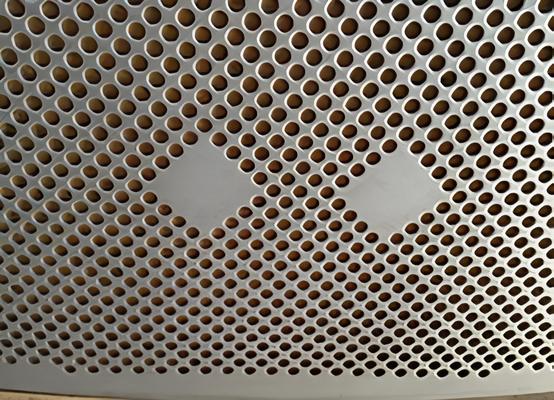
اختيار العملية المناسبة لمشروعك
الاعتبارات الرئيسية للاختيار بين الثقب والتثقيب والطمس
يعتمد اختيار العملية الصحيحة على عدة عوامل:
- حجم الجزء وشكله
- حجم الإنتاج
- الدقة المطلوبة
- خصائص المواد
غالباً ما يكون الثقب هو الأفضل للفتحات الصغيرة في الصفائح الرقيقة. يناسب الثقب الفتحات الكبيرة أو الأشكال المعقدة. يعتبر الطمس مثاليًا للأجزاء المسطحة الكاملة بأحجام كبيرة.
نوع المادة وسُمكها: كيف تؤثر على القرار
تلعب خصائص المواد دورًا حاسمًا في اختيار العملية:
- صفائح رقيقة (أقل من 3 مم): مناسبة لجميع العمليات الثلاث
- سمك متوسط (3-6 مم): أفضل للتثقيب أو الطمس
- مواد سميكة (> 6 مم): قد تتطلب طرق بديلة
كما أن نوع المادة مهم أيضاً:
- المعادن اللينة (الألومنيوم والنحاس): العمل بشكل جيد مع جميع العمليات
- المعادن الصلبة (الفولاذ، التيتانيوم): قد تحتاج إلى أدوات أقوى أو تقنيات مختلفة
ضع في اعتبارك دائماً خصائص المواد عند اختيار طريقة التصنيع.
اعتبارات التكلفة: ما هي العملية الأكثر اقتصاداً؟
تختلف فعالية التكلفة بناءً على عدة عوامل:
حجم الإنتاج:
- حجم منخفض: قد يكون الثقب أو التثقيب أكثر اقتصاداً
- حجم كبير: يصبح الطمس أكثر فعالية من حيث التكلفة
تكاليف الأدوات:
- ثقب: انخفاض التكاليف الأولية للثقوب البسيطة
- اللكم: اعتدال تكاليف الأدوات
- التقطيع: أعلى استثمار أولي للأدوات الأولية
النفايات المادية:
- الثقب واللكم: الحد الأدنى من النفايات
- التقطيع: يمكن أن تنتج خردة كبيرة
سرعة الإنتاج:
- جميع العمليات سريعة، ولكن غالبًا ما يكون للطمس أعلى معدل إخراج
ضع في اعتبارك كلاً من التكاليف الأولية ونفقات الإنتاج على المدى الطويل. يعتمد الخيار الأكثر اقتصاداً على متطلبات مشروعك المحددة وحجم الإنتاج.
خاتمة
يُعد الثقب واللكم والطمس عمليات رئيسية في تصنيع المعادن. ولكل منها نقاط قوة فريدة من نوعها. فالثقب يصنع ثقوبًا صغيرة ودقيقة. يوفر الثقب تعدد الاستخدامات للفتحات الكبيرة. ويتفوق الطمس في إنتاج القِطع ذات الحجم الكبير.
يعتمد اختيارك على الاحتياجات المحددة لمشروعك. ضع في اعتبارك عوامل مثل حجم الجزء وحجم الإنتاج وخصائص المواد. يمكن أن تؤثر العملية الصحيحة بشكل كبير على الجودة والكفاءة والتكاليف.
هل تحتاج إلى شركة تصنيع قطع صفائح معدنية موثوقة؟ شنجن هي المكان المناسب للذهاب إليه. نحن متخصصون في السحب العميق وقطع الصفائح المعدنية بالليزر والختم والتشطيب السطحي والتصنيع باستخدام الحاسب الآلي. تواصل مع شنغن اليوم وطلب المساعدة من المتخصصين!
الأسئلة الشائعة
هل يمكن إجراء الثقب واللكم والطمس على نفس الماكينة؟
يمكن للعديد من الماكينات بنظام التحكم الرقمي الحديثة أن تقوم بالثلاثة معًا، ولكن المعدات المتخصصة غالبًا ما تحقق نتائج أفضل. ستحدد احتياجات الإنتاج وقدرات المعدات الخاصة بك أفضل نهج.
ما هي العملية الأكثر ملاءمة للمواد الرقيقة؟
يمكن لجميعها التعامل مع المواد الرقيقة، ولكن غالباً ما يكون الثقب هو الأفضل للصفائح الرقيقة والثقوب الصغيرة. وعادةً ما توفر أعلى دقة وأقل تشويه للمواد الرقيقة.
كيف تقارن تكاليف هذه العمليات؟
تختلف التكاليف بناءً على الأدوات، وسرعة الإنتاج، ومخلفات المواد. عادةً ما يكون الثقب أقل التكاليف الأولية، في حين أن الطمس هو الأسرع بالنسبة للأحجام الكبيرة. بالنسبة للأشواط الصغيرة، قد يكون الثقب أو التثقيب أكثر فعالية من حيث التكلفة. بالنسبة للأحجام الكبيرة، يمكن أن تعوض سرعة الطمس التكاليف الأولية الأعلى.
مهلا، أنا كيفن لي

على مدى السنوات العشر الماضية، كنت منغمسًا في أشكال مختلفة من تصنيع الصفائح المعدنية، وشاركت رؤى رائعة هنا من تجاربي عبر ورش العمل المتنوعة.
ابقى على تواصل

كيفن لي
لدي أكثر من عشر سنوات من الخبرة المهنية في تصنيع الصفائح المعدنية، وتخصصت في القطع بالليزر، والثني، واللحام، وتقنيات معالجة الأسطح. كمدير فني في شنغن، أنا ملتزم بحل تحديات التصنيع المعقدة ودفع الابتكار والجودة في كل مشروع.

